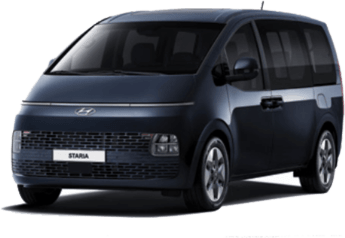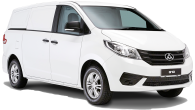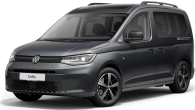Hyundai has taken on a lot of bold challenges in recent years - launching a performance car range, expanding into electric vehicles and introducing a radical new design language - but its latest move may be the hardest.
Hyundai is trying to make people movers cool.
While some countries around the world have embraced the practical nature of the people mover, Australians remain wedded to our preference for seven-seat SUVs. Style over space is the local credo, with far more SUVs finding use as large family transport than people movers - or as some mums call them, vans.
That's despite the obvious benefits of a van-based people mover, like the just-replaced Hyundai iMax. It has space for eight and their luggage, which is more than many SUVs can boast, plus it's easier to get in and out of a mini bus than any SUV you can currently buy.
But people movers have a history of driving more like a delivery van, which puts it at a disadvantage compared to SUVs. Kia has tried to push its Carnival closer and closer to an SUV, and now Hyundai is following suit - albeit with a unique twist.
The all-new Staria replaces the iMax/iLoad, and instead of being a people mover based on a commercial van it's the opposite - the Staria-Load will be based on the underpinnings of the people mover (which are borrowed from the Santa Fe).
What's more it has a new look that Hyundai claims is "not just cool for a people mover, it's cool full stop". That's a big call, so let's see how the new Staria shapes up.
Hyundai Staria 2022:
| Engine Type | Diesel Turbo 4, 2.2L |
|---|---|
| Fuel Type | Diesel |
| Fuel Efficiency | 8.2L/100km (combined) |
| Seating | 8 |
| Price From | $35,530 - $42,240 |
| Safety Rating |
|
Does it represent good value for the price? What features does it come with?
8 / 10
Hyundai is offering a sizeable Staria range with three specification levels with the choice of either a 3.5-litre V6 petrol 2WD or 2.2-litre turbo diesel with AWD across all variants.
The range begins with the entry-level model, known simply as Staria, which starts at $48,500 for the petrol and $51,500 for the diesel (MSRP - all prices exclude on-road costs).
.jpg)
Standard equipment on the base grade includes 18-inch alloy wheels, LED headlights and taillights, keyless entry, multi-angle parking cameras, manual air-conditioning (for all three rows), a 4.2-inch digital instrument panel, a leather-clad steering wheel, cloth seat trim, a six-speaker stereo and an 8.0-inch touchscreen with wireless Apple CarPlay and Android Auto and a wireless smartphone charging pad.
Stepping up to the Elite means pricing starts at $56,500 (petrol 2WD) and $59,500 (diesel AWD). It adds keyless entry and push-button start, power-sliding doors and a power tailgate, as well as leather upholstery, a power-adjustable driver's seat, DAB digital radio, a surround view camera system with 3D view, tri-zone climate control and a 10.2-inch touchscreen with in-built navigation but wired Apple CarPlay and Android Auto.
.jpg)
Finally the Highlander tops the line-up with a starting price of $63,500 (petrol 2WD) and $66,500 (diesel AWD). For that money you get a 10.2-inch digital instrument panel, dual power sunroof, heated and ventilated front seats, a heated steering wheel, rear passenger view monitor, cloth headlining and the choice of beige and blue interior colour finish, which costs $295.
On the topic of colour choices, there is only one no-cost option for paint, Abyss Black (you can see it on the base model diesel Staria in these images), while the other options - Graphite Gray, Moonlight Blue, Olivine Gray and Gaia Brown - all cost $695. That's right, there's no white or silver available - those are reserved for the Staria-Load parcel van.
.jpg)
Is there anything interesting about its design?
8 / 10
As mentioned earlier, not only is the design of the Staria different, Hyundai has made it the key selling point for the new model. The company uses words like "sleek", "minimalist" and "futuristic" to describe the look of the new model.
The new look is a major departure from the iMax and means the Staria looks like nothing else on the road today. The front end is what really sets the tone for the Staria, with the low-set grille flanked by the headlights with a horizontal LED daytime running light spanning the width of the nose above the headlight clusters.
At the rear the LED taillights run vertically, which accentuates the height of the van, and a roof-mounted spoiler that adds to the unique look.
It's certainly a striking look but fundamentally the Staria still has the overall shape of a van, which does detract slightly from Hyundai's attempts to push it to SUV buyers. Whereas the Kia Carnival now blurs the line between people mover and SUV with its pronounced bonnet, the Hyundai definitely falls much closer to the traditional van look.
It's also a polarising look, unlike the conservative iMax, which may help dissuade as many potential buyers as it attracts. But Hyundai is seemingly determined to make its entire range of vehicles make a statement rather than play it safe.
.jpg)
How practical is the space inside?
8 / 10
While it may sit on new underpinnings shared with the Santa Fe, the fact that it still has a van-like shape means it has van-like practicality. As such there's loads of room inside the cabin and that makes it ideal for transporting a large family or group of friends with ease.
All Staria models come standard with eight seats - two individual seats in the first row and three-person benches in the second and third. Even with the third row in use there's a spacious 831 litres (VDA) of luggage room.
One of the potential issues for families is the entry-level model misses out on the power sliding doors of the higher-grades, and the doors are so large children will have trouble closing them on anything other than flat ground; due to the sheer size of the doors.
Hyundai has ensured maximum flexibility for Staria owners by allowing both the second and third rows to tilt and slide depending on the space you need - passenger vs cargo. The second row has a 60:40 split/fold, while the third row is fixed.
The middle row has two ISOFIX child seat restraints in the outboard positions, and three top-tether child-seat restraints too, but amazingly, for a large family-focused vehicle like this, there are no child-seat anchor points in the third row. That puts it at a disadvantage compared to the likes of the Mazda CX-9 and Kia Carnival, among others.
However, the base of the third row folds upwards, which means the seats can be made narrower and slide forward to allow for up to 1303L (VDA) of cargo capacity. It means you can trade-off legroom and boot capacity depending on your needs. The two rear rows can be positioned in such a way as to provide ample head and knee room for adults in every passenger seat, so accommodating eight is no stretch for the Staria.
The boot area is wide and flat so it can take plenty of luggage, shopping or whatever else you need. Unlike the closely-related Carnival that has a recess in the boot that can both store luggage or stow the third row seats, the flat floor is necessary because the Staria comes with a full-size spare mounted underneath the boot floor. It can be dropped easily from the floor by a large screw, which means you don't need to clear the boot out if you need to put the spare on.
The load-in height of the boot is nice and low, which will likely be appreciated by families trying to wrangle kids and cargo. However, on the flipside the tailgate is too tall for children to close it on their own, so an adult or teenager will need to be responsible for that - at least on the base model, as the Elite and Highlander have power tailgates (albeit with the 'close' button mounted high on the boot lid or on the key fob, which may not be close to hand). It does come with an automatic close function, bringing the tailgate down if it detects no-one is in the way, although it can be annoying if you want to leave the tailgate up while you load the back; you can turn it off but have to remember each time.
.jpg)
For all of its space, what really impresses about the cabin is the thoughtfulness of the layout in terms of storage and usability. There are air-conditioning vents for both rear rows, and you get pop out windows on the sides too, but not proper wind-down electric windows in the doors like you find in the Carnival.
There are 10 cup holders in total, and there are USB charging ports in all three rows. The huge centre console box between the front seats can not only swallow plenty of items and hold a pair of drinks, it also houses a pair of pop-out cup holders and a storage draw for the middle row.
Up front there's not only the wireless charging pad but a pair of USB charging ports, cup holders integrated into the top of the dashboard and a pair of flat storage spaces on the top of the dash itself where you can stow small items.
.jpg)
What are the key stats for the engine and transmission?
7 / 10
As mentioned earlier there are two options - one petrol and one diesel.
The petrol is the new Hyundai 3.5-litre V6 that makes 200kW of power (at 6400rpm) and 331Nm of torque (at 5000rpm). It sends power to the front wheels via an eight-speed automatic transmission.
The 2.2-litre four-cylinder turbo diesel makes 130kW (at 3800rpm) and 430Nm (from 1500-2500rpm) and uses the same eight-speed auto, but comes equipped with all-wheel drive (AWD) as standard - a unique selling point over the front-wheel-drive-only Carnival.
Towing capacity is 750 kilograms for unbraked trailers, and up to 2500kg for braked towing.
How much fuel does it consume?
7 / 10
The V6 may have more power but it comes at the expense of fuel consumption, rated at 10.5 litres per 100km on the combined cycle (ADR 81/02). The diesel is the pick for those worried about fuel economy, with it rated at 8.2L/100km.
On test we saw higher returns than those claims, but largely because (due to current pandemic-induced restrictions) we weren't able to do any extended highway runs. However, around town we managed to get the V6 using 13.7L/100km, which is less than the urban claim of 14.5L/100km. We also managed to beat the claim for the diesel (10.4L/100km) with a return of 10.2L/100km during our test drive.
Warranty & Safety Rating
What safety equipment is fitted? What safety rating?
9 / 10
The Staria is yet to get rated by ANCAP, so it's unclear how it stacks up in an independent crash test. It's reportedly due to get tested later this year and Hyundai is confident the vehicle has what it takes to achieve a maximum five-star rating. It does come loaded with safety features, even on the base model.
For starters there are seven airbags, including a centre front passenger ‘bag that drops between driver and front seat occupant to avoid a head clash. Importantly the curtain airbags cover both the second and third row occupants; not something all three row SUVs can claim.
It also comes with Hyundai's SmartSense suite of active safety features that includes forward collision warning with autonomous emergency braking (from 5km/h to 180km/h) including pedestrian and cyclist detection (operable from 5km/h to 85km/h), blind-spot warning with collision avoidance, adaptive cruise control with lane following assist, lane keeping assist (speeds above 64km/h), junction assist to stop you from turning in front of oncoming traffic if the system deems it unsafe, rear cross-traffic collision-avoidance, rear occupant alert, and safe exit warning.
The Elite grade adds Safe Exit Assist which uses the rear radar to detect on-coming traffic and sound an alert if an on-coming car is approaching and won't allow the doors to open if the system believes it isn't safe to do so.
The Highlander gets a unique blind spot view monitor which uses the side-mounted cameras to display a live video image onto the instrument panel. This is an especially useful feature, as the large sides of the Staria create a large blind spot; so it's unfortunate it's not fitted to the other models in the range.
What does it cost to own? What warranty is offered?
9 / 10
Hyundai has kept it really simple with ownership costs thanks to its 'iCare' program that offers a five-year, unlimited kilometre warranty and capped price servicing.
Service intervals are every 12-month/15,000km and each visit costs $360 regardless of which powertrain you choose, for the first five years at least. You can pay as you go for maintenance, or there's a pre-paid service option if you wish to roll that annual cost into your finance payments.
Maintain your car with Hyundai and the company will top up your roadside assistance for 12 months after each service, too.
What's it like to drive?
7 / 10
Aside from exterior styling, this is the area where Hyundai has really tried to separate the Staria from the iMax it replaces. Gone are the previous commercial vehicle underpinnings and instead the Staria utilises the same platform as the latest generation Santa Fe; which also means it's similar to what's underneath the Kia Carnival. The idea of this change is to provide the Staria with a more SUV-like driving experience and for the most part it works.
It's important to note, however, that there are some important differences between the Staria and the Santa Fe - it's not just as simple as different bodies on the same chassis. The most significant change is arguably the wheelbase, which measures 3273mm on the Staria. That's a huge 508mm difference, providing the Staria with a much larger cabin space and altering the way the two models handle. It’s also worth pointing out that the Staria's wheelbase is 183mm longer than the Carnival, underlining just how large it is.
This new platform with the long wheelbase translates to a very composed people mover on the road. The ride is a big leap forward on the iMax, offering much better control and higher levels of comfort. The steering is also improved, feeling much more direct and responsive than the model it replaces.
.jpg)
However, the extra size of the Staria, it’s overall length is 5253mm and its 1990mm tall means it still feels like a big van on the road. As mentioned earlier it has a blind spot and it can be tricky to manoeuvre in confined spaces and car parks thanks to its dimensions. It also tends to lean when cornering thanks to its relatively high centre-of-gravity. Ultimately, while a major improvement on the iMax, it still leans more towards feeling like a van rather than an SUV.
Under the bonnet the V6 offers plenty of punch, but does feel slow to respond at times because it takes the transmission a few moments to get the engine into the sweet spot in the rev range (which is way, way up high in the revs).
The turbo-diesel, on the other hand, feels much better suited to the task at hand. With more torque than the V6 available from lower in the rev range (1500-2500rpm compared to 5000rpm) it feels much more responsive.
Verdict
Hyundai has taken some big risks with the Staria in an attempt to try and make the people mover cool and it's safe to say the company has built something no-one has ever seen before.
More important than being cool, though, Hyundai needs to attract more buyers to the people mover segment, or at least away from the Carnival. That's because Kia sells more people movers than the rest of the segment combined, accounting for nearly 60 per cent of the total market in Australia.
By being bold with the Staria Hyundai has made a vehicle that stands out from the pack but still does the job it's intended to do. Look beyond the "futuristic" appearance and you'll find a people mover with a spacious, thoughtfully laid out cabin with loads of equipment and a choice of engine and trim levels to suit a variety of budgets.
The sweet spot in the range is arguably the Elite diesel, offering plenty of creature comforts and the superior powertrain in terms of both real-world performance and fuel economy.
Now all Hyundai has to do is convince buyers that people movers really can be cool.
Pricing Guides

Range and Specs
| Vehicle | Specs | Price* |
|---|---|---|
| Base | 2.2L, Diesel, 8 SPEED AUTOMATIC | $35,530 - $42,240 |
| Elite | 2.2L, Diesel, 8 SPEED AUTOMATIC | $41,470 - $48,840 |
| Highlander | 2.2L, Diesel, 8 SPEED AUTOMATIC | $44,000 - $51,150 |





.jpg)
.jpg)
.jpg)
.jpg)
.jpg)
.jpg)

.jpg)
.jpg)
.jpg)
.jpg)
.jpg)
.jpg)
.jpg)
.jpg)
.jpg)
.jpg)

.jpg)
.jpg)
.jpg)
.jpg)
.jpg)
.jpg)
.jpg)
.jpg)
.jpg)
.jpg)
.jpg)
.jpg)
.jpg)
.jpg)
.jpg)
.jpg)
.jpg)
.jpg)
.jpg)
.jpg)








.jpg)
.jpg)



